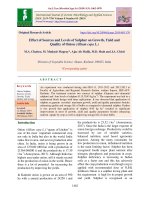Effects of multi-micronutrient mixture on growth, yield and quality of the summer pearl millet (Pennisetum glaucum L.)
Bạn đang xem bản rút gọn của tài liệu. Xem và tải ngay bản đầy đủ của tài liệu tại đây (193.26 KB, 8 trang )
Int.J.Curr.Microbiol.App.Sci (2019) 8(4): 783-790
International Journal of Current Microbiology and Applied Sciences
ISSN: 2319-7706 Volume 8 Number 04 (2019)
Journal homepage:
Original Research Article
/>
Effects of Multi-Micronutrient Mixture on Growth, Yield and Quality of
the Summer Pearl Millet (Pennisetum glaucum L.)
V.H. Kadivala*, V.P. Ramani and P.K. Patel
Micronutrient Project (ICAR), Anand Agricultural University, Anand 388 110, Gujarat, India
*Corresponding author
ABSTRACT
Keywords
Multi-micronutrient
mixture, Summer
pearl millet, Yield,
Crude protein
Article Info
Accepted:
07 March 2019
Available Online:
10 April 2019
A field experiment was conducted on loamy sand soil of Anand (Gujarat) during summer
season of the year 2017 to study the effects of multi-micronutrient mixture on growth,
yield and quality of the pearl millet (Pennisetum glaucum L.). The soil used for the
experiment was alkaline in reaction with low in available N and high in available P 2O5 and
K2O. With respect to DTPA-micronutrients, Fe and Mn was deficient, while Zn and Cu
were sufficient in status. The higher grain yield was obtained with the 1% foliar spray of
multi-micronutrient mixture grade-III (for Fe deficiency) having concentration of Fe-6.0%,
Mn-1.0%, Zn-4.0%, Cu-0.3% and B-0.5% at 15, 30 and 45 DAT (Days after
Transplanting). While straw and total yield was higher under the soil application of
micronutrients of 50 kg FeSO4.5H2O ha-1 and 40 kg MnSO4.3H2O ha-1 as per STV (Soil
Test Value). Micronutrient supplementation through 1.0% foliar application of the mixture
having concentration of Fe-4.0%, Mn-1.0%, Zn-6.0%, Cu-0.5% and B-0.5% (Grade-IV for
Zn and Fe deficiency)was also found beneficial in increasing ear head length, grain, straw
and total yield of summer pearl millet.
poor man’s food. It is the most drought
tolerant crop among cereals and millets.
Introduction
Micronutrient deficiencies are becoming
increasingly common in agriculture as a result
of higher levels of removal by ever-moreproductive crops combined with breeding for
higher yields, at the expense of micronutrient
acquisition efficiency. The, systematic studies
for delineation of micronutrients in Gujarat
reported 25% Zn and 25% Fe in different
soils of Gujarat. The deficiency of Mn was
also found to encores in some parts of the
state (Anon. 2014-15). Pearl millet
(Pennisetum glaucum L.) is one of the major
coarse grain crops and is considered to be a
The diminishing use of micronutrients has
lead to the occurrences of widespread
deficiency of micronutrients especially of Zn
and Fe which warrants the need for research
on Zn and Fe on their usage individually and
in mixtures as foliar/soil application.
Therefore, the experiment was planned to
study the effects of multi-micronutrient
mixture on growth, yield and quality of the
pearl millet.
783
Int.J.Curr.Microbiol.App.Sci (2019) 8(4): 783-790
of micronutrients (50 kg FeSO4.5H2O ha-1 and
40 kg MnSO4.3H2O ha-1) on soil test value i.e.
STV basis and control as well.
Materials and Methods
A field experiment was conducted at Main
forage Research Station, AAU, Anand during
summer season of the year 2017 for studying
effects of multi-micronutrients mixture in
improving production of summer pearl millet
(Pennisetum glaucum L.) (GHB-558).The
treatment was comprised of T1-control, foliar
spray treatments: T2-multi-micronutrient
mixture
grade-I
(general),
T3-multimicronutrient mixture grade-II (for Zn
deficiency), T4-multi-micronutrient mixture
grade-III (for Fe deficiency), T5-multimicronutrient mixture grade-IV (for Zn & Fe
deficiency) and soil application treatments:
T6-multi-micronutrient mixture grade-V and
T7-soil application of micronutrients as per
soil test value (STV). The multi-micronutrient
mixture grades having concentration shown in
table 1 were prepared on the basis of average
removal of micronutrients by different crops
(grades I and IV) and other grades (II to IV)
on the basis of wide spread occurrences of Zn
or Fe or Zn and Fe deficiencies in soils of
Gujarat. The multi-micronutrients mixture
facilitate the application of the wide range of
plant nutrients in the proportion and to suit
the specific requirements of a crop in different
stages of growth, and are more relevant under
site specific nutrient management practices.
Therefore, there is a need to promote
balanced fertilization for which use of
appropriate
multi-micronutrient
mixture
grades would play a big role to improve
nutrients use efficiency and enhance crops
productivity for food and nutritional security.
The treatments were replicated four times in a
randomized block design. The soil of the
experimental field was Typic Ustochrepts,
loamy sand in texture and had pH1:2.5-7.96,
EC1:2.5-0.44 dS m-1, organic carbon-3.65 g kg1
, available N- 188 kg ha-1, available P2O580.70 kg ha-1, available K2O-301.6 kg ha-1,
available S-9.24 mg kg-1, Fe-4.20 mg kg-1,
Mn-4.39 mg kg-1, Zn-1.20 mg kg-1, Cu-0.59
mg kg-1 and B-0.37 mg kg-1. Before field
preparation the pearl millet nursery was raised
at Model laboratory, Micronutrient Research
Project (ICAR) during February, 2017. The
soil was collected from the experimental site
and filled in micro plot and then pearl millet
seed were broadcasted and nursery was
prepared as per recommendation. After
fertilization, pre-transplanting irrigation was
given to the experimental plot. The uniform
healthy seedlings of pearl millet cv. GHB–
558 having an age of twenty days were
uprooted after applying the irrigation to the
nursery and one seedling per hill was
transplanted at 45 cm x 10 cm spacing.
The field observation on plant height, ear
head length, no. of effective tillers, test
weight, grain and straw yield were recorded.
Plant height was recorded at 30, 45 DAT and
at harvest for five randomly selected tagged
plants in each net plot and average was
calculated and recorded separately. The ear
head length from the some randomly tagged
five plants was used for studying this
character. Length of five ear heads was
measured in centimetre from the cut end of
the ear head to the tip of the ear head and
mean was worked out and recorded plot wise.
Number of effective tillers per meter row
length was recorded from net plot area at
harvesting of crop. From the composite
samples of grain of each net plot, 1000 seeds
The rate of application of different grades for
foliar spray was kept 1%. The foliar
application was made during crop growth
period with three sprays at 15, 30 and 45
DAT (Days after Transplanting) of the crop
and the soil application of grade-V was 20 kg
ha-1 as basal. The treatments were tested
against the standard recommended application
784
Int.J.Curr.Microbiol.App.Sci (2019) 8(4): 783-790
were counted and the weight was recorded in
g for all the experimental plots. The produce
of each net plot was threshed separately,
cleaned and the grain yield was recorded in
kg per net plot and then converted into kg ha1
. Straw yield was obtained by subtracting the
grain yield of each net plot from their
respective total dry matter (Above ground)
yield and computed in terms of kg ha-1 and
converted it on hectare basis. The percentage
protein of grains was worked out by Lowry’s
method (Lowry’s et al., 1951). The soil
samples drawn from the experimental field at
harvest were analysed for available
micronutrients by extracting with 0.005 M
DTPA (Lindsay and Norvell, 1978) and the
contents were determined on atomic
absorption spectrophotometer. Boron content
in soil was determined by spectrophotometer
using azomethine-H by hot water method
(Datta et al., 2002). The plant samples were
taken for determination of contents of
micronutrients. Then samples were dried in
paper bags at 70ºC in hot air oven till constant
weight and ground in stainless steel grinder
and were digested in di-acid mixture of
HNO3:HClO4 (4:1) as per procedure outlined
by Lindsay and Norvell (1978). Boron content
in grain and straw samples was analysed by
dry ashing method (Page et al., 1982).
of pearl millet for different treatments are
presented in table 3. An appraisal of data
revealed that the three foliar spray of 1%
multi-micronutrient mixture Grade-IV (grade
for Zn & Fe deficiency) at 15, 30 and 45 DAT
recorded significantly the higher ear head
length (23.40 cm) of pearl millet, over
control. However, the T5 was at par with soil
application (T6) of 20 kg ha-1 multimicronutrient mixture (Grade-V) and STV
(Soil Test Value) 50 kg FeSO4.5H2O ha-1 and
40 kg MnSO4.3H2O ha-1 which was also
resulted in increase of ear head length. The
increase in head length with the application of
multi-micronutrient mixture Grade-IV might
be due to Grade-IV is deficient in Zn and Fe
and the soil was low in available Fe status,
their supplementation in balanced form along
with other micronutrients might have played
an important role to mitigate the hidden
hunger of the crop for micronutrients.
Although the micronutrients are required in a
small quantity, there supplementation during
the crop growth help in better utilization of all
other nutrients which in turn result in increase
of crop growth of maize (Patel et al., 2009).
Further, the results revealed that there were
no significant effect of multi-micronutrient
mixture on No. of effective tillers, test weight
and harvest index of pearl millet.
Results and Discussion
Yield
Growth
Foliar application of 1% multi-micronutrient
mixture Grade-III (grade for Fe deficiency) at
15, 30 and 45 DAT recorded significantly
higher grain yield of pearl millet (2291 kg ha1
), wherein an overall increase of 299 kg ha-1
was observed over control (1992 kg ha-1). It
was remained at par with three foliar spray of
1% multi-micronutrient mixture Grade-II
(grade for Zn deficiency) and Grade-IV (for
Zn & Fe deficiency) and soil application of
Grade-V (T6) and Soil Test Value (STV)
treatment. The increase in grain yield of pearl
millet could be attributed to greater response
The effect of multi-micronutrient mixture on
plant height of pearl millet at 30, 45 DAT and
at harvest are presented in table 2. The little
improvement in plant height of pearl millet
was noticed at 30, 45 DAT and at harvest due
to different treatments of multi-micronutrients
mixture, but did not reach the level of
significance.
The data on ear head length, no. of effective
tillers, test weight of grain and harvest index
785
Int.J.Curr.Microbiol.App.Sci (2019) 8(4): 783-790
of applied Grade-III (Fe deficiency) may be
due to experimental soil was deficient in
available Fe. The effect of Fe on grain yield
can also be explained on the basis of
relatively higher doses of Fe tended to
produce more vegetative growth resulting
from efficient utilization of nutrients, water,
radiation and increased metabolic activities
followed by increased translocation toward
yield contributing characters, which might
have led to significant increase in grain yield.
Further, the addition of the micronutrients
also helps in better utilization of the major
nutrients to produce higher yield of crops.
Earlier workers, Chandrakumar et al., (2004),
Singh and Ram (2005) and Esfahani et al.,
(2014) have also reported similar increase in
yield of wheat and rice due to Fe and/or Zn
application under different agro-climatic
conditions. Patel and Singh (2010) also found
the beneficial effect of multi-micronutrients
could be the balanced nutrition of the crops
and thereby improved crop growth as well as
yield.
et al., 2014, Abid et al., 2002 and Keram et
al., 2012).
Since, site of experiment was categorized as
low with regard to soil available Mn, its
supplementation through soil application
might have increase that Mn-containing
enzymes viz. alcohol dehydrogenase, carbonic
anhydrase,
alkaline
phosphatase,
phospholipase, carboxypeptidase, and RNA
polymerase which improve the photosynthetic
activity and translocation.
Good responses to Mn fertilization in terms of
attaining high crop yield on Mn-deficient
soils have been reported by (Nayyer et. al.,
1985; Soni 1996; Sharma and Bapat 2000;
Bansal and Khurana 2002; Varshney et al.,
2008; Dhaliwal et al., 2009).
Khan et al., (2008) also reported
improvements in wheat yield with soil
application of Mn. They indicated that the
apparent mechanism for improvements in
wheat yield due to application of Mn might be
due to the increase in leaf area index,
providing an improved resource generating
base for the crop i.e. an improved
carbohydrate source. The consequence of this
improved source is the improvement in
overall
biomass
and
consequently
improvements in yield components of the
crop.
The application of micronutrients of 50 kg
FeSO4.5H2O ha-1 and 40 kg MnSO4.3H2O ha1
as per STV (Soil Test Value) increased
straw (4906 kg ha-1) and total (7138 kg ha-1)
yield of pearl millet was significantly higher
over control. The maximum increase of 702
kg ha-1 and 942 kg ha-1was observed
respectively, over control. However, in case
of straw yield it was at par with T3 (Grade-II),
T4 (Grade-III) and soil application (Grade-V),
while total yield was at par with T3 (GradeII), T4 (Grade-III), T5 (Grade-IV) and T6
(Grade-V) (Table 4). It’s might be due to the
favourable effect of applied Fe on these
growth parameters may be ascribed to
synergetic effect of Fe on most of the
photosynthesis, physiological and metabolic
processes of the plant followed by increased
translocation toward yield contributing
characters, which might have led to
significant increase in straw yields of rice (Ali
Crude protein
The mean data regarding protein content in
pearl millet grain as influenced by multimicronutrient mixture application are
presented in table 5.
The result revealed that there was no
significant effect of application of multimicronutrient mixture on protein content of
pearl millet.
786
Int.J.Curr.Microbiol.App.Sci (2019) 8(4): 783-790
Table.1 Composition of different grades
Sr.
No.
1.
2.
3.
4.
5.
Grade
Fe
2
2
6
4
2
LF Grade I (General)
LF Grade II (For Zn deficiency)
LF Grade III (For Fe deficiency)
LF Grade IV (For Zn & Fe deficiency)
LF Grade V (Soil application)
Mn
0.5
0.5
1.0
1.0
0.5
Content (%)
Zn
4.0
8.0
4.0
6.0
5.0
Cu
0.3
0.5
0.3
0.5
0.2
B
0.5
0.5
0.5
0.5
0.5
Table.2 Effect of multi micronutrient mixture on plant height (cm) of pearl millet
Treatments
T1: Control
T2: Grade-I (FS)
T3: Grade-II (FS)
T4: Grade-III (FS)
T5: Grade-IV (FS)
T6: Grade-V (SA)
T7: STV
SEm ±
CD at 5%
CV (%)
30
DAT
73.3
73.1
73.9
73.3
72.8
73.9
77.2
1.3
NS
3.5
Period
45
DAT
117
118
119
119
118
123
122
1.8
NS
3.0
At
Harvest
121.80
125.10
125.85
125.33
126.30
126.30
126.05
1.78
NS
2.85
Table.3 Effect of multi micronutrient mixture on growth of pearl millet
Treatments
T1: Control
T2: Grade-I (FS)
T3: Grade-II (FS)
T4: Grade-III (FS)
T5: Grade-IV (FS)
T6: Grade-V (SA)
T7: STV
SEm ±
CD at 5%
CV (%)
Ear head
length (cm)
20.98
22.18
22.45
22.18
23.40
23.15
22.50
0.34
1.00
3.01
No. of tillers
per meter row
length
24.63
25.42
25.26
25.24
28.00
25.70
24.09
1.07
NS
8.36
787
Test weight
(g)
Harvest
index (%)
7.78
7.90
8.18
8.05
8.14
8.13
8.15
0.13
NS
3.29
32.13
31.72
32.35
33.07
32.97
32.04
31.27
1.03
NS
6.41
Int.J.Curr.Microbiol.App.Sci (2019) 8(4): 783-790
Table.4 Effect of multi micronutrient mixture on yield (kg ha-1) of pearl millet
Treatments
T1: Control
T2: Grade-I (FS)
T3: Grade-II (FS)
T4: Grade-III (FS)
T5: Grade-IV (FS)
T6: Grade-V (SA)
T7: STV
SEm ±
CD at 5%
CV (%)
Grain
1992
2014
2214
2291
2268
2260
2232
63
187
5.8
Straw
4204
4345
4650
4654
4615
4792
4906
140
417
6.1
Total
6196
6359
6863
6945
6883
7052
7138
141
419
4.1
Table.5 Effect of multi micronutrient mixture on protein content of pearl millet
Treatments
T1: Control
T2: Grade-I (FS)
T3: Grade-II (FS)
T4: Grade-III (FS)
T5: Grade-IV (FS)
T6: Grade-V (SA)
T7: STV
SEm ±
CD at 5%
CV (%)
Protein content (%)
1.97
1.90
2.00
1.91
1.81
1.94
1.98
0.06
NS
6.17
In conclusion, the results of the present study
indicated that from yield point of view, soil
application as per STV (Soil Test Value) or
application of multi-micronutrient mixture
(except Grade-I) were found significantly
superior over control. Foliar application and
soil application of multi-micronutrient
mixture grades found comparable with STV
indicated that chemical load can reduce
without affecting the yield of pearl millet.
foliar application at 15, 30 and 45 DAT (Days
after Transplanting) of summer pearl millet.
References
Abid, M., Ahmad, N., Jahangir, M. and
Ahmad, I. (2002) Effect of Zn, Fe and
Mn on growth and yield of rice (Oryza
sativa L.). Pakistan Journal of
Agricultural Science39, 101-103.
Ali, H., Hasnain, Z., Shahzad, A.N. and
Sarwar, N. (2014) Nitrogen and zinc
interaction improves yield and quality
of submerged basmati rice (Oryza
sativa L.). Notulae Botanicae Horti
Agrobotanici Cluj-Napoca42, 372-
Thus, the finding of the present study
suggested that agronomic approach for yield
and
micronutrients
concentration
enhancement could be better accomplished by
its supplementation through soil (basal) or
788
Int.J.Curr.Microbiol.App.Sci (2019) 8(4): 783-790
379.
Anonymous, (2014-2015). Annual Progress
Report,
Micronutrient
Research
Project (ICAR), AAU, Anand.
Bansal, R.L. and Khurana, M.P.S. (2002)
Foliar application of Zn and Mn
Fertilizers on Yield and Yield
attributes of wheat. Journal of Indian
Society of Soil Science, 45, 35-39.
Chandrakumar, K., Halepyati, A.S., Desai,
B.K. and Pujari, B.T. (2004) Grain
yield, dry matter production and its
portioning in wheat var. DWR-195 as
influenced by organics, macro,
micronutrients
and method of
application. Karnataka Journal of
Agricultural Science17, 10-16.
Datta, S.P., Rattan, R.K., Suribabu, K. and
Datta, S.C. (2002) Fractionation and
colorimetric determination of boron in
soils.Journal of Plant Nutrition and
Soil Science165, 179-184.
Dhaliwal, S.S., Sadana, U.S., Manchanda, J.S.
and
Dhadli,
H.S.
(2009)
Biofortification of wheat grains with
Manganese in Typic Ustochrept soils
of Punjab. Indian Journal of
Fertilizers5, 13-16 & 19-20.
Esfahani, A.A., Pirdashti, H. and Yousuf, N.
(2014) Effect of Fe, Zn, and Si
application on quantitative parameters
of rice. International Journal of
Farming and Allied Sciences, 3, 529533.
Keram, K.S., Sharma, B.L. and Sawarkar, D.
(2012) Impact of Zn application on
yield, quality, nutrients uptake and soil
fertility in a medium deep black soil.
International Journal of Science,
Environment and Technology1, 563571.
Khan, M.A., Fuller, M.P. and Baloch, F.S.
(2008) Effect of soil applied zinc
sulphate on wheat (Triticum aestivum
L.) grown on a calcareous soil in
Pakistan. Research Communications,
36, 571–582.
Lindsay, W.L. and Norvell, W.A. (1978)
Development of DTPA soil testing for
Zn, Fe, Mn, and Cu. Soil Science
America Proc. Journal 42, 421-428.
Lowry, O.H., Rosebrough, N.J., Farr, A.L.,
and Randall, R.J. (1951) J. Biol.
Chem193, 265 (The original method).
Nayyar, V.K., Sadana, U.S. and Takkar, T.N.
(1985) Method and rates of
application of Mn and its critical level
for wheat following rice on coarse
textured soils. Fertilizer Research8,
173-178.
Page, A.L., Millen. R. and Keeney, D.R.
(1982) Methods of soil Analysis, Part
2-Chemical
and
microbiological
properties, Second Edition. Agronomy
Society of America Madison, WI.
Patel, K.P. and Singh, M.V. (2010)
Management
of
micronutrients
deficiencies for enhancing yield of
crops. World congress of soil science,
Soil solutions for changing world,
Australia.
Patel, K.P., Patel, P.C., Patel, K.C. and
Ramani, V.P. (2009) Effect of multimicronutrients mixture on yield,
micronutrient uptake and quality of
fodder maize (Zea mays L.) grown on
Typic Ustochrepts soils of Anand.
Gujarat
Agricultural
University
Research Journal34, 44-48.
Sharma, B.L. and Bapat, P.N. (2000) Levels
of micronutrient cations in various
plant parts of wheat as influenced by
zinc and phosphorus application.
Journal of the Indian Society of Soil
Science48, 130-134.
Singh, V. and Ram, N. (2005) Effect of 25
years of continuous fertilizer use on
response to applied nutrients and
uptake of micronutrients by ricewheat-cowpea
system.
Cereal
Research Communications, 33, 589594.
789
Int.J.Curr.Microbiol.App.Sci (2019) 8(4): 783-790
Soni, (1996) Influence of rates and methods
of manganese application on yield and
nutrition of wheat in a reclaimed sodic
soil. The journal of Agricultural
Science127, 434-439.
Varshney, P., Singh, S.K. and Srivastava, P.C.
(2008) Frequency and rates of zinc
application under hybrid rice-wheat
sequence in a Mollisol of Uttarakhand.
Journal of the Indian Society of Soil
Science56, 92-98.
How to cite this article:
Kadivala, V.H., V.P. Ramani and Patel, P.K. 2019. Effects of Multi-Micronutrient Mixture on
Growth, Yield and Quality of the Summer Pearl Millet (Pennisetum glaucum L.).
Int.J.Curr.Microbiol.App.Sci. 8(04): 783-790. doi: />
790

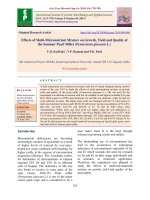
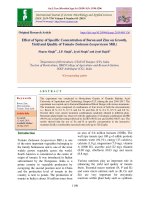
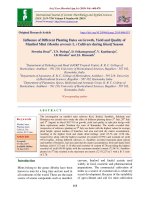
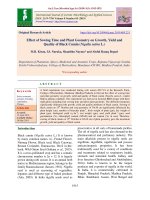
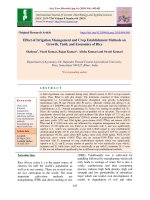
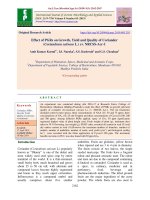
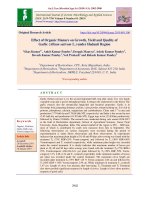
![Genetic analysis for micronutrients and grain yield in relation to diverse sources of cytoplasm in pearl millet [Pennisetum glaucum (L.) R. Br.]](https://media.store123doc.com/images/document/2020_01/13/medium_ion1578932058.jpg)
